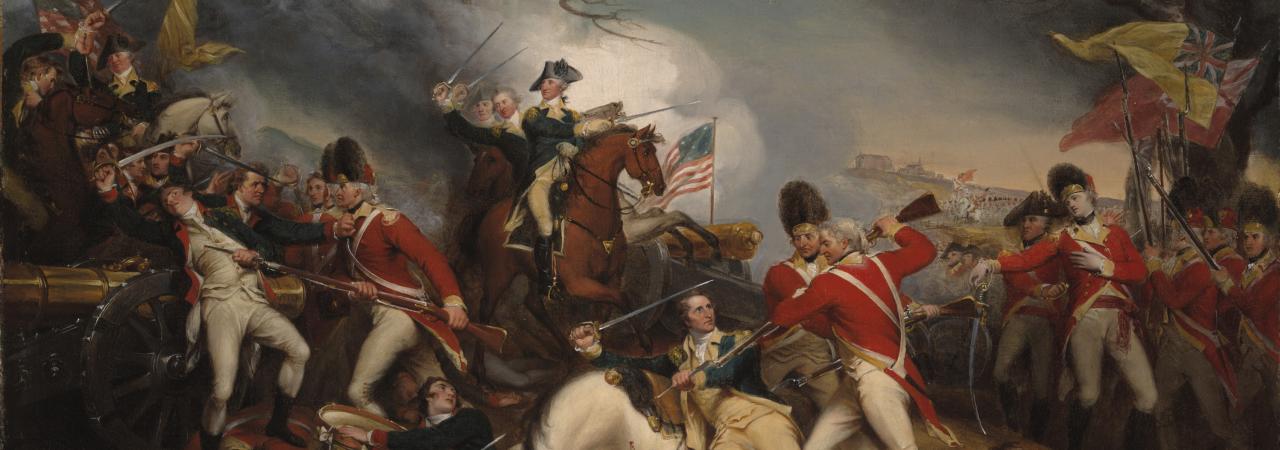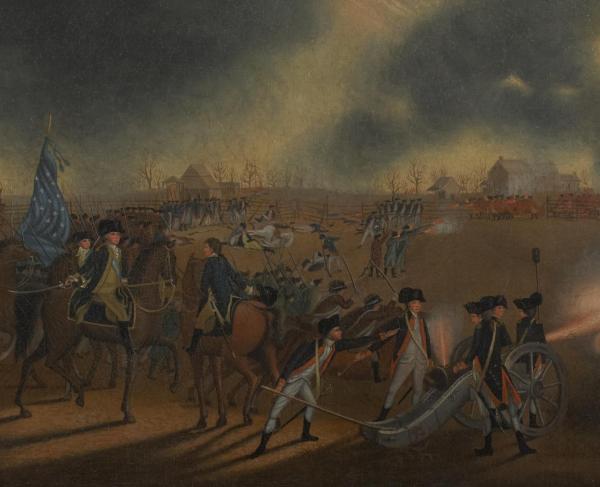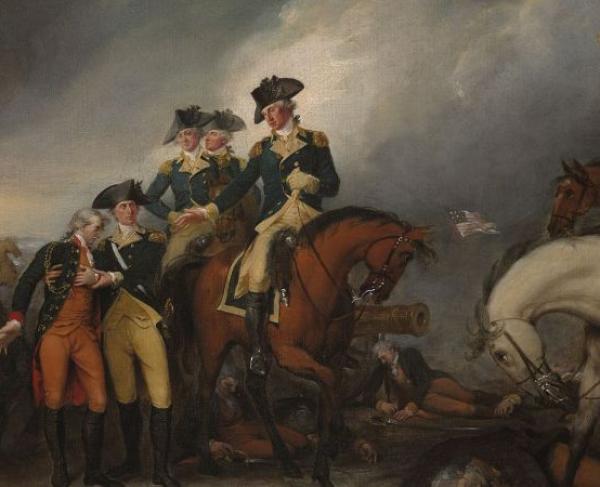
In his famed “Battle of Princeton” painting, 18th-century artist John Trumbull celebrates George Washington’s heroic arrival on the battlefield (on a brown horse, with Dr. Benjamin Rush) and depicts British grenadiers bayoneting Washington’s friend, Gen. Hugh Mercer. Mercer died 9 days later in the battlefield’s Thomas Clarke House, despite Dr. Rush’s care.
During the early part of the American Revolution, the amateur soldiers that made up the Continental Army struggled to overcome the British Regulars. Until Baron von Steuben’s training at Valley Forge in 1778, General George Washington often could not rely on his inexperienced men to hold the battle line against the British. Washington’s solution was his artillery. Under the command of the gifted Henry Knox, and bolstered with mariners who were used to serving their guns at sea, Washington’s artillery was equal to, or better than, their British counterparts. In addition, captured cannons and those supplied by the French provided an abundance of artillery, even if Knox struggled throughout the war to find the correct ammunition for the wide variety of calibers.
By the end of 1776, the Revolution was in a crisis, and Washington needed a victory to revitalize the war effort. Washington knew that his inexperienced troops and militia were unequal to a fight against the British, or their Hessian allies, so his strategy hinged on brining overwhelming firepower to the battlefield. At Trenton, Washington brought eighteen field cannon to counter the six Hessian guns. At the Battle of the Assunpink Creek, the Americans brought forty cannon, while the British fielded twenty-eight. Finally, at Princeton, Washington brought thirty-five cannon, while the British only had eight. These three battles would help turn the tide of the Revolution, and were won with the help of Washington’s artillery. Here is a look at four commanders of artillery batteries during this crucial campaign:
Alexander Hamilton
After the Battles of Lexington and Concord, young Alexander Hamilton joined a student militia unit, the Corsicans, later Hearts of Oak, at King’s College (Columbia). Hamilton was deeply interested in military history and tactics, leading to his promotion, despite his age. In August of 1775, Hamilton and the Hearts of Oak participated in a raid on The Battery in New York City, capturing the fortifications' cannons. The Hearts of Oak put the cannon to good use, and converted to an artillery unit. A year later, in 1776, Hamilton raised his own artillery company, the New York Provincial Company of Artillery, using the Hearts of Oak to form its core, and was elected its Captain.
Answering George Washington’s call as the war moved south from Boston, the New York Artillery joined the Continental Army for the campaigns of 1776. When the Continentals were driven from Manhattan, the New York Artillery saw action throughout, particularly at White Plains. As Washington retreated across New Jersey, Hamilton and his men dutifully followed, Washington knew that he would need his artillery for the next campaign.
When Washington crossed the Delaware River on Christmas of 1776, Hamilton, and the New York Artillery, crossed with him. While the crossing was difficult for the infantry, it was extremely difficult for the artillery, which had to drag their cannon up the slick, ice and snow covered banks of the Delaware. Their dedication would be repaid the next morning at Trenton.
Attached to General Nathaniel Greene’s division, Hamilton and his men approached Trenton from the north, along the Pennington Road. When Washington’s Continentals surprised the Hessian garrison at Trenton, he ordered Colonel Henry Knox to support the infantry with a heavy artillery concentration. Knox, in turn, occupied the highest point near the town, the intersection of King’s and Queen’s Streets, and the Pennington and Princeton Roads. Hamilton and his guns took up positions on an artillerists’ dream, high ground with clear fields of fire and enemy targets in the open. The dream was short lived, however, as two Hessian cannon opened fire on the hill. Hamilton’s battery of two guns went into action quickly and efficiently, providing counterbattery fire to their Hessian opponents. After a brief exchange, and as Continental infantry also started to pour fire on the Hessian artillery, the Hessians broke and ran, abandoning their guns.
Hamilton and his men then turned their cannon on the Hessian infantry, throwing round shot and canister down the closely packed streets of Trenton. When the smoke cleared on December 26, 1776, Washington had won a stunning victory at Trenton, and his artillery had proven their importance.
A week later, at the Battle of Princeton, Hamilton and the New York Artillery would again be called to action. Advancing with the main body towards Princeton, Hamilton missed the fight around the Clarke farms. Instead, the New Yorkers engaged the 55th Regiment of Foot along Frog Hollow Ravine, and then followed as they retreated towards town. The British retreated to Nassau Hall, hoping to turn the large building into a ready-made fortress. Hamilton brought his guns up, and after a brief bombardment compelled the British to surrender.
The intrepid and efficient young artillery officer had commanded his cannon so well during the Ten Crucial Days that many senior officers in the Continental Army offered Hamilton a place on their staff. Hamilton refused, however, wanting to remain in a combat command, until Washington himself offered. The young artillerist became Washington’s de facto Chief of Staff and one of the most trusted young officers in his “military family.”
Thomas Forrest
Thomas Forrest began his military carrer on October 5, 1776 as a Captain in Colonel Thomas Proctor’s Pennsylvania Artillery Battalion. Joining Washington and the rest of the Continental Army from Philadelphia, Forrest and his men endured the rigors of crossing the Delaware with the main force. At the Battle of Trenton, Forrest commanded the Second Company, Pennsylvania State Artillery, which contained two brass six-pounders and two five-and-a-half inch howitzers.
Marching with Greene’s division, Forrest and his men also occupied the high ground alongside Hamilton’s New York Artillery and Captain Sebastian Bauman’s New York Company of Continental Artillery. After winning a quick but deadly artillery duel with two Hessian cannon, Forrest’s battery turned their attention to Colonel Johann Rall and his infantry. When Rall heard that his cannon had been abandoned, he turned his regiment around in an attempt to recapture them. This exposed his men’s western flank en enfilade to the Continental gunners. Forrest and his men capitalized on Rall’s error, sending round shot and canister ripping down the length of the Hessian line, to devastating effect. Soon thereafter, the Hessians surrendered. The two captured Hessian cannons seemed to have been integrated into Forrest’s company.
Forrest and his Pennsylvanians were called back into action on January 2, 1777, now with six guns. During the running fight along the King’s Highway between Princeton and Trenton, Forrest’s company supported Colonels Edward Hand’s infantry as they fought a delaying action against the British. As the Continentals retreated through Trenton, Forrest’s company took up positions south of Assunpink Creek, along a ridge with a clear field of fire over the critical Assunpink Bridge. Forrest supported the retreat of the Continental rearguard, and then waited for the main British assault over the bridge.
First came the Hessian Grenadiers, who were turned back under a hail of musketry and artillery. Next, the British formed dense columns and attempted to storm the bridge. Forrest’s guns swept the bridge with round shot to devastating effect. The British reformed and tried again, only to be met by a withering hail of lead. Finally, as the British formed for a final attempt, Forrest ordered his cannon loaded with canister and to fire by section. When the British made their attempt, the Continental cannon all fired together. The result was a bridge that “looked red as blood, with their killed and wounded and their red coats.” Washington’s artillery had again thwarted British professionalism.
Thomas Forrest ended his military career on October 7, 1781, five years after he had enlisted, as a lieutenant colonel. He went on to have a distinguished political career, serving in Congress for two terms.
Daniel Neil
Little is known about Captain Daniel Neil other than his Revolutionary War service. Neil enlisted in the Eastern Company of the New Jersey Artillery on February 18, 1776, with the rank of Captain Lieutenant (first lieutenant). He was promoted to Captain on May 9 of the same year. Neil and his company were active in New Jersey throughout 1776, and crossed the Delaware with Washington on December 26.
During the Battle of Trenton, Neil and the East Jersey Artillery were attached to General John Sullivan’s division, attacking Trenton from the west. His guns supported Sullivan’s attack on the Knyphausen Regiment and then helped secure Assunpink Bridge. Neil’s finest hour, however, was to come a week later.
On January 3, 1777, as the Continental Army approached Princeton, Neil and his company were reassigned to General Hugh Mercer’s brigade. When Mercer was detached by General Nathanael Greene to engage the British, Neil and his two cannon advanced in support. Mercer ran headlong into elements of the 17th Regiment of Foot and a pitched battle erupted. Neil’s battery began throwing round shot at the approaching British lines as quickly as they could load and fire.
Mercer’s men could not withstand the onslaught and began to waver. When Mercer attempted to rally his men, his horse was shot from under him, and he was bayonetted and left for dead. His second in command, Colonel John Haslet attempted to restore order, but was killed instantly, leaving the Continentals leaderless. Neil ordered one cannon to withdraw with the infantry, staying behind to help cover the retreat with his second gun. Neil was unable to withdraw the second cannon, and was killed while he worked his gun. His sacrifice helped cover the withdraw of the remainder of Mercer’s men. Captain Neil’s final resting place is unknown, and it is possible that he lies buried in the mass grave located on Princeton Battlefield.
Joseph Moulder
Captain Joseph Moulder, born in 1714, was a veteran sailor by the time the Revolution began. His ties to the sea likely gave him an extensive knowledge of artillery, the primary defense mechanism on any ship, military or civilian. Moulder lived and worked in Philadelphia, and was a member of the famed Philadelphia Associators, a militia unit Benjamin Franklin helped form, commanding the Second Company of Artillery as its Captain.
At the venerable age of 62, Captain Moulder and his Associators joined Washington’s army on the banks of the Delaware in December of 1776. Because many of Moulder’s men were recruited from the Philadelphia docks, they proved invaluable during the crossing, assisting Colonel John Glover’s famed Marbleheaders in ferrying the army across the river. Moulder’s Company was attached to Sullivan’s Division for the attack on Trenton, and would see action on the west side of town.
On January 2, 1777, when the rest of the Continental Army was again engaged at Trenton, the Associators were stationed at Crosswicks, about ten miles from the fighting. Moulder and the Associators missed the fighting, but they were recalled to the main body on the night of January 2 and attached to Nathanael Greene’s Division for the attack on Princeton. They marched overnight at the rear of the column and were in the reserve, not likely to see action.
January 3 would bring a surprise for Moulder and his artillery, as they crossed the fields on the outskirts of Princeton, they heard and saw the sharp and deadly engagement between Hugh Mercer’s men and the British Regulars. In a prime position along the ridge by Thomas Clarke’s house, Moulder saw Mercer’s men fleeing from the orchard and farmyard of William Clarke, across the small vale. A portion of Colonel John Cadwalader’s Associators rushed to meet the British and protect the fleeing Continentals. Moulder, an experienced artillerist, chose his position superbly, posting his two long four-pounders on a shoulder of the ridge by Thomas Clarke’s house.
As Mercer’s men fled through the lines of the Associators, the panic began to spread. When the neat lines of British Redcoats, with bayonets at the charge, swept down the vale, some of the Americans began to break. With the majority of the Continental Army on the field breaking around him, Moulder coolly placed his guns. Opting to load with canister, or grapeshot, instead of round shot, Moulder’s men delivered a withering hail of lead into the approaching British. Working their guns as quickly as they could, Moulder and his men knew that failure meant death or capture for themselves, and defeat for the army.
Moulder, and the Associators that did not break, halted the British in their tracks, buying enough time for more Continentals, and George Washington himself, to arrive. Washington and Cadwalader were able to rally the men and reformed them along the ridge. As more and more Continentals arrived, the tide began to turn in favor of the Americans; by the end of the battle, Washington had yet again stunned the British.
Joseph Moulder did not see much action after Princeton, retiring to Philadelphia he died in 1779, never to see the victory he helped achieve. However, had it not been for the 62-year-old sailor and his two cannon, the Revolution could have ended very differently.
Related Battles
5
905
75
270


